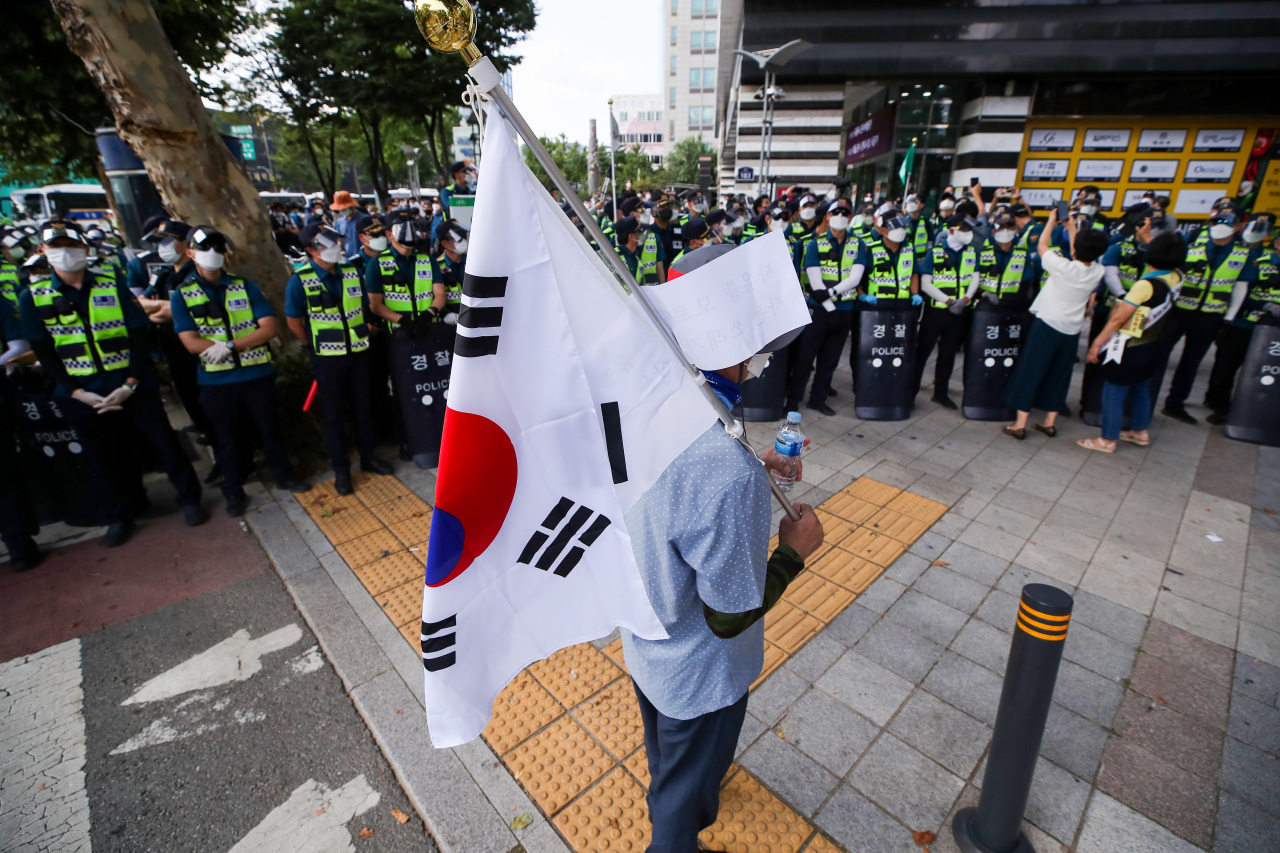One-person demonstrations against the Moon Jae-in administration were held all around central Seoul districts the morning of the National Liberation Day on Sunday, after attempts to stage a march in Gwanghwamun the previous day proved unsuccessful.
Police stationed guards at 81 major roads around the city and blockaded the central city boulevard with buses and fences from early Saturday to ward off any action.
The leaders of the weekend demonstrations previously insisted they would be “peacefully walking through” Seoul streets 2 meters apart from one another to avoid violating COVID-19 restrictions. Under current guidance, protests can be attended by only one person at a time.
But how dangerous are protests? Experts say it depends on the setting and the safety steps taken by those involved.
Dr. Jung Ki-suck, a former director of the Korea Centers for Disease Control and Prevention, said socially distanced outdoor events, including protests, “have minimal contagion risks” and “are arguably much safer than say, a maskless rendezvous at a cafe or restaurant.”
“Regardless, people must respect the guidance which says protests should strictly be a single-person affair,” he said.
“The public health communication should be clear that there is a risk any time people gather, and that people should avoid contact where they can not only during, but before and after the protests. No shouting or singing, or other activities that can emit respiratory droplets.”
That being said, Jung pointed out past protests that have taken place over the pandemic had not amounted to substantial spikes in infections.
On Liberation Day last year, tens of thousands of people gathered in Gwanghwamun Square to urge Moon to step down. Despite massive testing efforts, cases detected among the protesters were relatively few.
At the time, the government’s COVID-19 response headquarters ordered network operators to submit data to track down people who were around the area at the time. A test mandate was issued for anyone who was at or in the vicinity of Gwanghwamun that day for more than 30 minutes. A total of 20,830 people ended up being tested, including reporters covering the event. Just 1 percent -- 280 -- tested positive.
Many of the cases discovered in the weeks following the particular protest were instead linked to churches, as restrictions on in-person services eased in the summer, some of whose members were found to be present at the protest. Even then, the climb in cases after the protest peaked at 441, less than half of the cases counted at the peak of the first wave in February.
In early October, neither labor union rallies calling for workplace safety nor a “drive-thru” parade against “unconstitutional infringement of the right to assembly,” in which protesters drove past the main road of Gwanghwamun separately in nine cars bearing placards, resulted in a rise in cases afterward.
In July, about 8,000 members of the Korean Confederation of Trade Unions rallied in the streets of Jongno over “regressive” labor laws, with only three cases tied to those in attendance confirmed to date.
Warnings were issued ahead of the weekend to discourage possible social distancing violations as the Liberation Day protests proceed.
Seoul Mayor Oh Se-hoon said those engaging in any actions considered illicit under the current COVID-19 emergency could face legal consequences. Interior Minister Jeon Hae-cheol likewise vowed a “stern response,” urging protesters to abort their plans.
Protests have been unequivocally met with strong denunciation from political figures throughout the pandemic.
Last year, then-Cheong Wa Dae chief of staff Noh Young-min called organizers of an anti-Moon protest “murderers,” while Kim Boo-kyum, a former Democratic Party of Korea lawmaker who is now the prime minister, referred to them as “terrorists waging biological warfare against the nation.”
Ahead of the October drive-thru parade, Moon condemned it as an “antisocial crime” and warned that there would be “no tolerance of any kind” if they went through with it. Lee Nak-yon, a onetime prime minister from the ruling party, urged police to “block the protest and similar actions that threaten public safety like fate depends on it.”
Dr. Chun Eun-mi, a respiratory disease specialist at Ewha Womans University Medical Center, said while it is true there is less risk outside, the fourth wave of the pandemic is still in full swing, and any large-scale public gatherings could nonetheless affect social distancing behaviors. “The idea is to limit nonessential activities as much as possible,” she said.
Still, “since we’re in this for the long haul, there could be a safer way to permit protests,” she said, rather than banning them altogether.
“Have only PCR-negative people partake in the event, for instance. Then after protesting, people should be advised to seek testing to see there hasn’t been a spread,” she said.
Another public health expert, who wished to remain anonymous, said, “Somehow authorities are more restrictive toward protests, and I mean ones held outdoors, but from a scientific standpoint there are significantly riskier day-to-day activities that are permitted.”
“Entertainment facilities such as casinos and escort bars are staying open in the midst of the largest resurgence, but no one is taking issue with that,” he said.
Meanwhile the national vaccination campaign against COVID-19 has inoculated 43 percent of the country’s 51 million people with at least one dose of a vaccine since kicking off in February, according to official statistics updated Saturday at midnight. About 19 percent have been fully vaccinated.
Korea reported 1,817 more cases Sunday, marking the 40th consecutive day of over 1,000 cases. Since the pandemic began, 223,928 people here have been infected, of whom 2,156 have died.
By Kim Arin (
arin@heraldcorp.com)








